Disposing of used espresso pucks creates mess and inconvenience. Without a proper knock box, countertops get dirty and portafilters can be damaged. The right knock box offers cleanliness, convenience, and portafilter protection.
The perfect espresso knock box for home baristas features an off-center knock bar, adequate capacity for multiple shots, durable materials like stainless steel or hardwood, and a design that minimizes splatter. It should be easy to clean, compact enough for your counter space, and protect your portafilter from damage.
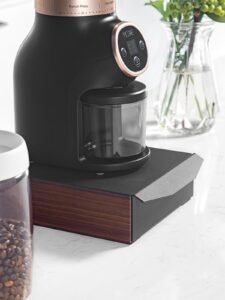
As a dedicated home barista, I've learned that the small details make a big difference in creating the perfect espresso experience. While we often focus on grinders, machines, and beans, tools like knock boxes are unsung heroes in maintaining a clean, efficient workflow. Let me share what I've discovered about these essential accessories.
Why Do Home Baristas Need a Dedicated Knock Box?
Every espresso shot leaves behind a compact puck of wet grounds. Without a proper disposal system, these pucks create messy countertops and clogged sinks. A dedicated knock box solves this frustrating problem immediately.
A knock box provides a designated space to dispose of used espresso pucks, preventing countertop mess, sink clogs, and potential damage to portafilters. It creates a cleaner workflow, makes cleanup easier, and helps maintain the quality of your equipment over time.
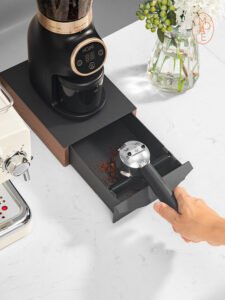
The Evolution of Home Knock Boxes
The humble knock box has come a long way from commercial café designs. Today's home versions balance functionality with aesthetics in ways that accommodate smaller spaces and different kitchen styles. I remember when my first knock box transformed my morning routine from a messy chore to a smooth ritual.
Modern knock boxes come in various sizes and configurations. Some integrate with trash bins, while others are standalone units with removable containers. The evolution has focused on making these tools more user-friendly and stylish for home environments. When I switched from knocking pucks into my regular trash to using a dedicated knock box, I immediately noticed less countertop mess and a more enjoyable workflow.
The design options now include:
| Style | Benefits | Best For |
|---|---|---|
| Standalone Boxes | Complete control over placement, easy emptying | Dedicated coffee stations |
| Drawer-Style | Space-saving, hidden when not in use | Small kitchens |
| Counter-Integrated | Seamless look, permanent solution | Custom coffee bars |
| Bin Attachments | Uses existing trash systems | Multiple users |
What Design Features Should You Look for in a Quality Knock Box?
Many knock boxes have centered knock bars, creating splash zones and messy counters. Poorly designed models also damage portafilter edges and don't contain loose grounds effectively. These frustrations ruin the espresso experience.
An effective knock box features an off-center knock bar positioned to direct pucks downward into the container. The bar should be cushioned to protect portafilter edges and reduce noise, while the container needs sufficient depth and a wide opening to catch stray grounds and prevent splatter.
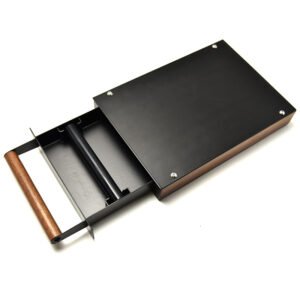
The Science Behind Effective Knock Box Design
The most effective knock boxes incorporate thoughtful engineering that might not be immediately obvious. The angle of the knock bar, the depth of the container, and even the material of the impact surface all contribute to functionality. I've tested dozens of models and found that these details make a significant difference in daily use.
The knock bar placement is particularly important. When positioned off-center, it creates a natural trajectory for the puck to fall directly into the container rather than bouncing or creating splatter. Some premium models use rubber or silicone-coated bars that absorb impact and reduce noise—a feature my family particularly appreciates during early morning coffee sessions.
Container depth also matters significantly. Too shallow, and grounds splash out; too deep, and it becomes difficult to clean properly. The ideal depth allows for multiple shots before emptying while remaining accessible for cleaning. Wide openings further reduce mess by catching stray grounds that might otherwise miss the target.
Some innovative designs I've encountered include:
- Magnetically attached knock bars for easier cleaning
- Angled interior surfaces to direct pucks toward the bottom
- Removable rubber gaskets that prevent grounds from getting trapped
- Measurement markers to indicate when emptying is needed
How Do Different Materials Affect Your Knock Box Experience?
Plastic knock boxes often crack or absorb coffee oils, becoming stained and unsanitary. Metal options can be noisy and damage portafilters, while poor-quality wood warps with moisture. These material failings lead to frequent replacements.
Knock box materials significantly impact durability, maintenance, and aesthetics. Stainless steel offers longevity and easy cleaning but can be noisy. Quality plastic provides affordability and lightweight convenience. Wood delivers visual appeal and noise reduction but requires more care to prevent moisture damage.
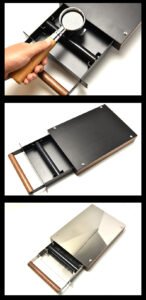
Material Performance Under Daily Use
After years of testing different knock boxes in my home setup, I've developed clear insights about how materials perform over time. Each option presents unique benefits and challenges worth considering before making a purchase.
Stainless steel knock boxes have become my personal favorite for longevity. They withstand thousands of impacts without deteriorating and don't absorb coffee oils or odors. The premium models feature rubber gaskets on knock bars that significantly reduce noise and protect portafilter edges. While they typically cost more initially, I've found they outlast plastic alternatives by years, making them more economical long-term.
Wooden knock boxes, particularly those made from maple or walnut, offer unmatched aesthetic appeal that integrates beautifully with high-end coffee stations. They naturally dampen sound and provide a warm, organic feel. However, they require more maintenance—I recommend treating wooden models with food-safe mineral oil every few months to prevent absorption and warping. Some manufacturers now offer hybrid designs with removable stainless containers inside wooden shells, combining benefits of both materials.
High-quality plastic models have improved dramatically in recent years. Premium ABS or polycarbonate construction resists cracking even under heavy use. While they may still stain over time, many now feature removable inner containers that can be thoroughly cleaned or even run through dishwashers. They remain the most affordable entry point and work perfectly well for lighter home use.
This comparison table summarizes my findings:
| Material | Durability | Noise Level | Maintenance | Price Range |
|---|---|---|---|---|
| Stainless Steel | Excellent | Moderate to High | Low | $30-80 |
| Wood | Good | Low | High | $40-120 |
| Premium Plastic | Moderate | Moderate | Moderate | $15-40 |
| Silicone | Good | Very Low | Low | $25-50 |
Where Should You Place Your Knock Box in a Home Coffee Station?
Limited counter space forces difficult choices about equipment placement. Many knock boxes are too large or unattractive, leading to resistance from household members who don't share your coffee passion. Finding the right balance is challenging.
Position your knock box within easy reach of your espresso machine to maintain workflow efficiency. For limited counter space, consider drawer-style models that slide under machines or wall-mounted options. In shared kitchens, look for designs that complement existing décor or can be stored away when not in use.

Strategic Placement for Maximum Efficiency
The placement of your knock box can significantly impact your coffee-making flow and the overall functionality of your space. Through trial and error in my own evolving coffee corner, I've discovered several strategic approaches worth considering.
For dedicated coffee bars, positioning the knock box directly adjacent to your espresso machine creates the most efficient workflow. This arrangement minimizes dripping between the machine and disposal point—a small detail that significantly reduces cleaning time. In my setup, I've found that placing the knock box slightly below the espresso machine's grouphead height allows for a natural motion when removing the portafilter and knocking out grounds.
In kitchens where counter space is at a premium, innovative solutions become necessary. Drawer-style knock boxes that slide under espresso machines utilize vertical space efficiently without expanding your coffee station's footprint. Some newer models attach directly to the side of espresso machines with custom brackets, creating zero additional counter requirements. When I downsized apartments, this type of solution became essential to maintaining my coffee routine.
The "spousal acceptance factor" is a real consideration for many home baristas. I've found that knock boxes with clean, minimal designs in materials that complement kitchen décor receive much less resistance from household members who might not share coffee enthusiasm. Some clever designs disguise their purpose entirely, resembling decorative containers until needed.
For truly space-constrained situations, consider these alternatives:
- Under-counter mounted knock boxes that pull out like small drawers
- Models that attach to existing trash bins with specialized adapters
- Collapsible silicone designs that can be stored flat when not in use
- Multipurpose options that incorporate tamping stations or tool storage
How Do You Properly Use and Maintain Your Espresso Knock Box?
Improper knocking technique damages portafilters and creates unnecessary mess. Without regular cleaning, knock boxes become breeding grounds for mold and unpleasant odors. These hygiene issues potentially contaminate your coffee area.
To use a knock box correctly, hold the portafilter firmly and tap the edge against the knock bar with medium force—enough to dislodge the puck but not damage the basket. Clean your knock box daily by emptying grounds and rinsing with warm water. Deep clean weekly by scrubbing with mild soap to prevent oil buildup and odors.
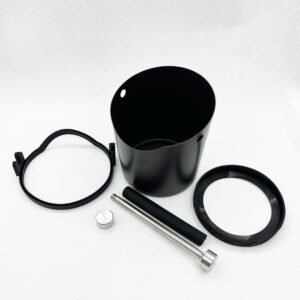
Mastering Knock Box Technique and Maintenance
The seemingly simple act of knocking out espresso pucks actually involves technique that can extend the life of both your equipment and knock box. After making thousands of espresso shots, I've refined a method that minimizes mess while protecting my gear.
The optimal knocking technique starts with proper portafilter grip. I hold it firmly with my dominant hand, wrapping all fingers around the handle for complete control. Rather than aggressively hammering the knock bar, I use a controlled tap against the side of the bar, allowing the portafilter to pivot slightly. This motion directs the puck downward rather than outward, significantly reducing splatter. If the puck doesn't release on the first tap, I repeat with slightly more force rather than immediately increasing impact strength.
The angle of contact matters significantly. Striking the knock bar with the portafilter at approximately 45-degrees creates the ideal force distribution to release the puck cleanly. This approach prevents damage to the filter basket rim that can occur with direct perpendicular impacts. I discovered this method after noticing premature wear on my earlier portafilters.
Regular maintenance ensures longevity and hygiene. My cleaning routine includes:
- Daily emptying and rinsing with warm water
- Weekly washing with mild dish soap and a bottle brush to reach corners
- Monthly deep cleaning by soaking removable parts in a solution of water and coffee equipment cleaner
- Quarterly inspection of knock bars for wear and tightening of any loose components
For wooden knock boxes, I apply food-grade mineral oil quarterly to prevent drying and cracking. Stainless steel models benefit from occasional polishing with microfiber cloths to maintain their appearance. Plastic containers should be checked regularly for cracks or stress marks that might indicate replacement is needed.
I've found that properly maintained knock boxes easily last 5+ years of daily use, making them a worthwhile investment for any serious home barista.
Conclusion
The perfect espresso knock box balances functional design with appropriate size and materials for your space. By choosing wisely and maintaining properly, this simple tool enhances your daily coffee ritual while protecting your equipment and keeping your area clean.
As a manufacturer of premium coffee accessories, I understand the importance of quality tools in the espresso-making process. At SIF Coffee Tools, we engineer our products with the serious home barista in mind, ensuring durability and performance that meets professional standards.




